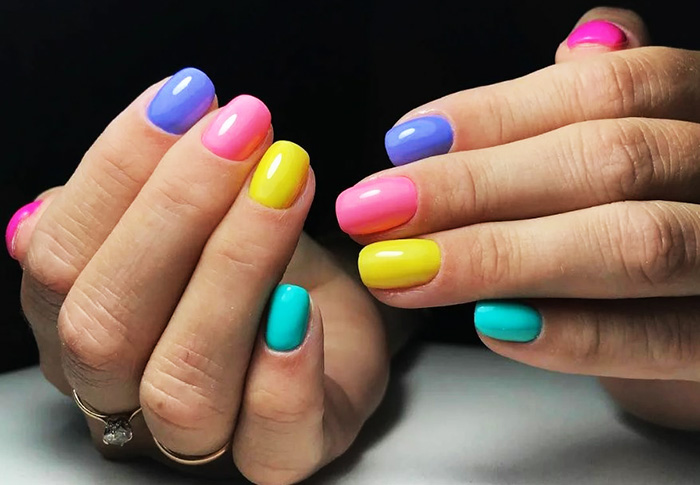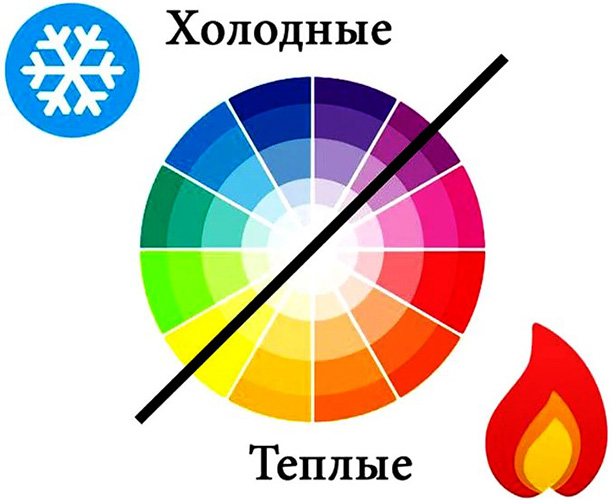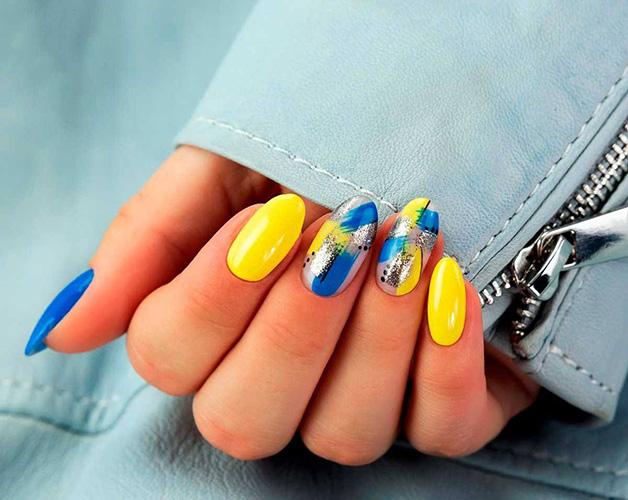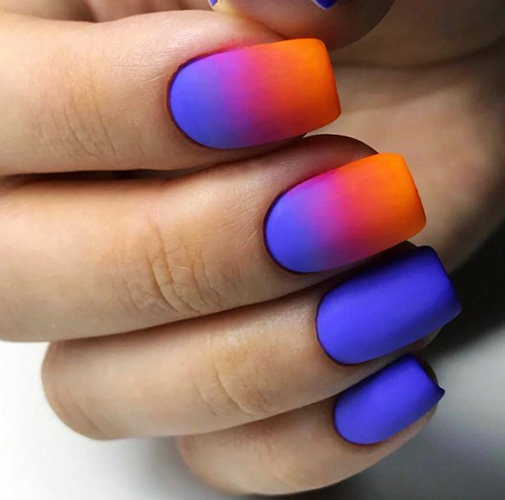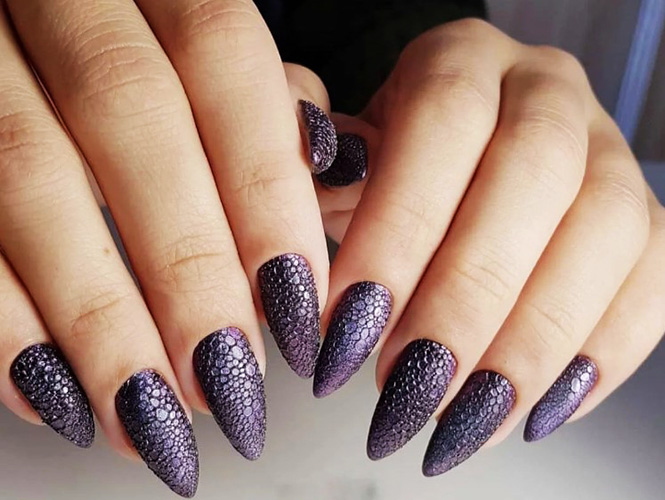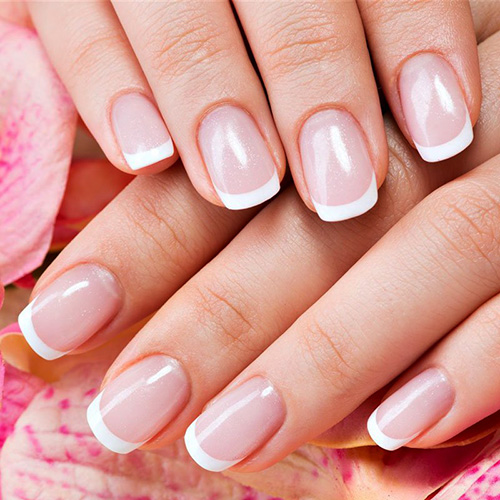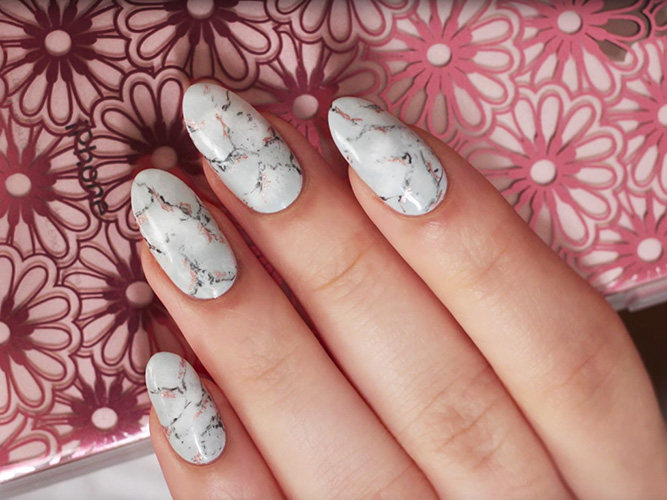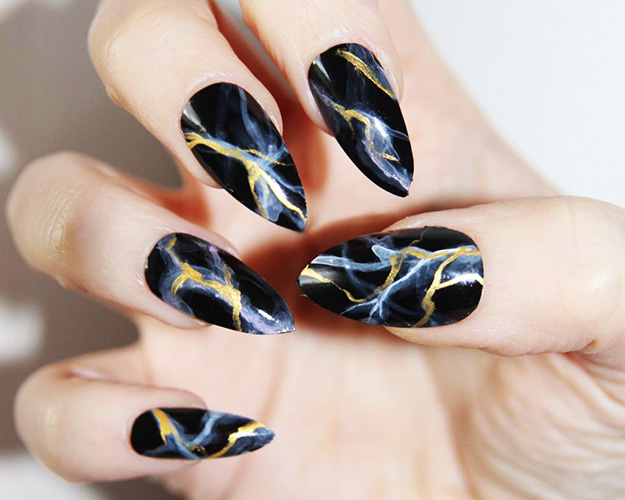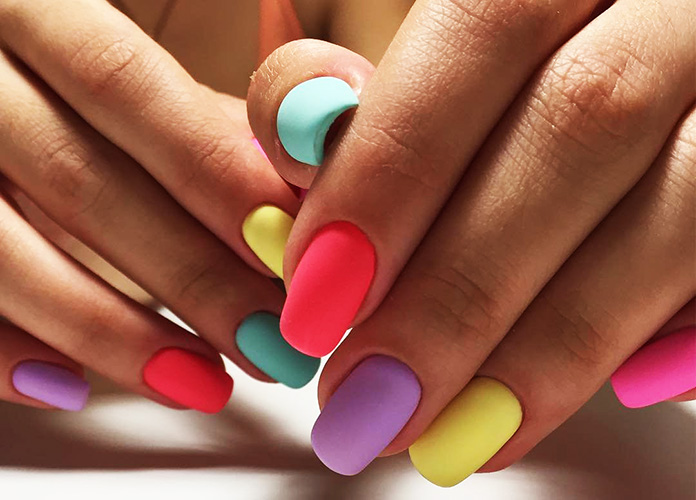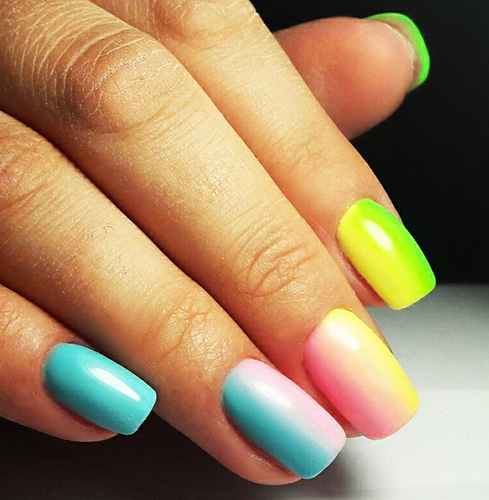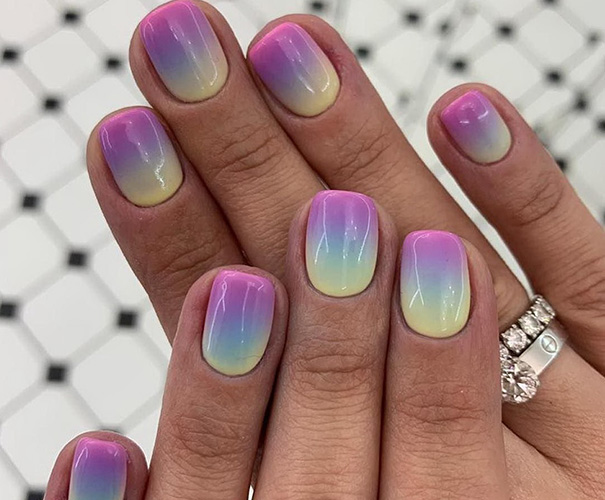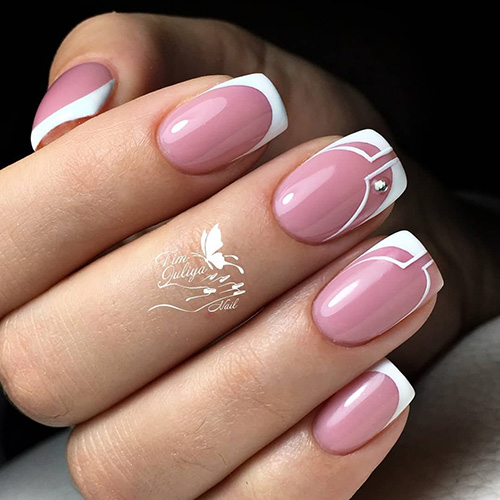When evaluating the work of a nail service master (from a photo or live), the first thing to assess is the ability to build the correct architecture, sawdust nails, and the absence of material detachments. However, the most quality manicure can be spoiled by the wrong color combination.
Color combinations
There are three main colors in color harmony:
- red;
- blue;
- yellow.
These colors are unique. They cannot be formed by mixing the shades found in nature. All other colors are a combination of base colors. The combination of two primary colors when mixed forms a secondary.
Table of colors that form the secondary order of the circle:
| Secondary color | The required combination of primary |
| Green |
|
| Violet |
|
| Orange |
|
Complementing the twelve-sector color wheel are colors of the tertiary order, formed by mixing the two previous ones, in different proportions. They have a shade in between basic and secondary.

Black and white are not included in the main palette. They are called achromatic, in the artistic sense they have no color. When mixing any color from a circle with achromatic tones, it becomes lighter or darker. White lacquer creates pastel tones, while black lacquer darkens.
All 12 colors are divided into warm and cold colors. Shades of yellow, orange, red are considered warm, and blue, green and purple are considered cold.
The combination of colors in manicure (photos of various options overwhelm the Internet) is carried out according to the most common color schemes:
- monochrome;
- contrasting;
- analog;
- triadic;
- tetraidal.
Each of the schemes is tied to a color wheel.
Their more detailed meaning and features are described in the table:
| Color scheme name | Features of the location on the color wheel |
| Monochrome | It is a combination of shades of the same color. Formed by mixing with white or black paint. Light ones are located closer to the center of the circle, dark ones on the outside, forming something like a sector. |
| Contrast | This diagram represents the use of diametrically opposite colors. The contrasting colors in the circle are opposite each other. |
| Analog | The scheme assumes the use of colors that are next to each other on a circle. It has a similarity to the monochrome scheme, but has a richer range of shades. |
| Triadic | The choice of the color combination is based on the construction of an equilateral triangle, the vertices of which will indicate the colors. In contrast to the contrasting scheme, it is calmer and more balanced. |
| Tetraidal | Geometry is based on a square, rectangle or trapezoid. Helps to determine the best combination of four colors. |
Fashion Techniques
The combination of colors in a manicure (photos are presented in the article) is an extensive topic.
Correct color matching is one of the most important steps in various techniques:
- gradient;
- amber;
- foam technique;
- French;
- marble technique.
The main condition for using these techniques is a harmonious combination of colors. Otherwise, when mixing, dirty shades are obtained, and when combined, it is nonsense. To avoid this situation, you must use the previously mentioned color schemes.
Gradient
A gradient is a smooth transition from one color to another.Mixing with each other, the primary colors form shades, making it visually impossible to determine the boundaries of colors. The technique is performed with densely pigmented gel polishes. They do not dry in the open air, which allows the material to be spread over the surface for the required amount of time.
To apply shades, use:
- flat brush;
- spongy sponge;
- polyurethane sponge.
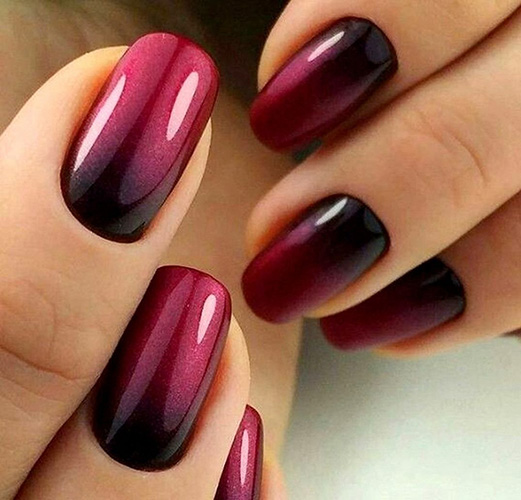
The choice of tool depends on the experience of the master. The brush has a dense short bristle at the base and thin and sparse closer to the free edge. For beginners, options with a sponge are suitable. You must first purchase a special composition to protect the cuticle and side rollers from excess paint.
Before proceeding with the implementation of the gradient in any of the ways, the surface of the nail must be painted in a base color (usually white), dried in a lamp and the dispersion removed.
Step-by-step flow chart of the gradient:
| Stages | Gradient brush | Sponge gradient |
| Preparatory | In some cases, top application. | Application of the composition to protect the skin. |
| Color application | Horizontal or vertical stripes on the nail starting from the cuticle. | Apply alternately to a sponge or foil. Press several times against the palette to remove air. |
| Material distribution | When applying color horizontally, the brush moves flat from one side roller to the other with a swiping motion. A vertical gradient is performed with a fan brush with swiping movements from the cuticle to the free edge. | With quick trampling movements, the sponge is pressed against the nail, controlling the pressure. Depending on the type of gradient (vertical / horizontal), the sponge is slightly displaced from the roller to the roller or from the cuticle to the free edge. |
| Number of layers | In this technique, gel polish is applied in a middle layer; for a bright result, two or three are enough. | The sponge absorbs most of the material, so three to five coats may be required. |
| Drying | Regardless of the method of execution, each layer goes through a full drying cycle. | |
| The final stage | Topcoat application, dispersion removal if necessary. | |
Gradient is unique in its ability to visually lengthen the nails. Nail technicians recommend using a monochrome or analog color scheme in this technique.
Ombre
The combination of colors in manicure (photos in the amber technique are presented below) allows you to expand the variability of the available designs with a small supply of gel polishes in your arsenal. The ombre technique is a kind of gradient. Represents a transition from dark to light shades. Most often, the free edge in this technique has a white tint.
The technique allows you to balance bright and saturated colors, adding lightness. It is carried out by analogy with a gradient brush or sponge.
For amber and gradient, in addition to gel polishes, the following materials can be used:
- rubbing;
- pigments;
- acrylic Powder;
- sequins.
The rub is applied to the freshly dried top without a sticky layer, rubbing in the material until a dense coating is obtained. For better grip, the result is overlapped with a sticky top, sealing the butt end. The pigment is applied with a fan brush on the top with a sticky layer and dried in a lamp. By analogy with rubbing in, overlap with a top coat with dispersion.
Acrylic powder is applied to the top with a fan brush or other handy tool, and then dried in a lamp. Dry glitter is mixed with the top and applied with a brush to the desired area. Due to the aggressive influence of the top on the pile of the brush, the masters recommend purchasing a separate one.
Foam manicure
Color combinations play a key role in foam manicure. The effect created by the bubbles depends on the density of the material, the correct combination of the base varnish shade and the top decorative one. You can compare contrasting and monochrome options from the photo.
Using the technique, the master gives the manicure various visual effects:
- fish scales;
- lunar surface;
- mineral;
- sea foam;
- reptile skin.
When using a contrasting color scheme, it is necessary to select diametrically opposite colors. Most often, craftsmen use a dark gel polish as a base coat and a lighter one for creating a bubble design.
This color combination, combined with fine bubbles, creates a visual resemblance to pumice and other porous minerals. The use of larger bubbles resembles craters on the lunar surface.
The use of gel polishes similar in tone makes the foam manicure more delicate and light.
French
French is an ideal solution for those who are poorly oriented in color schemes. This versatile technique allows you to create dramatic designs in any color. Camouflage bases and gels blend beautifully with the shades of the color wheel.
The exception is the jacket options using two gel polishes. The base color and shade for making a smile must be selected according to a contrasting color scheme. On the color wheel, these shades should be located opposite each other.
Marble technique
This express design, using various colors of gel polish and their density, allows you to create the following effects on nails:
- natural stone (marble, agate, charoite);
- epoxy resin pattern;
- paints or ink dissolved in water;
- flame, waves.
The technique is available for performing at home and for novice craftsmen. It allows you to combine two or more colors using all the previously listed color schemes. With analog and monochrome settings, the transition between colors will be softer and less noticeable. The rest of the combinations are more contrasting.
The colors mixed on the palette are transferred to the prepared nail using the ombre brush. Previously, its surface is covered with a top, to improve the distribution of material. The result is dried in a lamp and fixed with a top without a sticky layer.
To imitate metal particles in the stone, use a gel polish with sparkles of a suitable shade. It is added to the palette or applied after the design has dried.
Master classes
The combination of colors in manicure (photos of the master classes are presented below) is an extensive topic that requires a practical approach. That is why master classes are the best practical tool for mastering a skill.
They are step-by-step instructions and allow you to understand not only the basics of harmony and balance of color, but also in the implementation of knowledge in various design techniques.
A nail service master must have the following combination skills:
- multi-colored design;
- two-tone combination;
- technique of using three colors;
- ombre;
- french.
A master class for beginners and novice craftsmen is the basis for further modernizing or improving the refined design technique.
Multicolored
The simplest version of a multi-colored manicure is considered to be staining the fingers of one hand in various shades of gel polish. To maintain a balance between colors, you must use one of the color schemes of the twelve-part circle and gel polishes from the same series.
It is the same density of varnish and other characteristics that will combine different colors into a single composition.
Step-by-step execution scheme:
- After processing the cuticle and preparing the nail plate for coating (removing gloss with a buff, covering with a base), it is degreased and dried in the open air.
- The first layer of colored coating is applied to each finger in turn. Before applying neon shades, masters recommend applying a white base coat. Against the background of white, neon looks brighter.
- A complete drying cycle is carried out (UV - 2 min., LED - 1 min.). It is recommended to work with a conveyor, drying each finger after applying the varnish. Otherwise, the material may flow, forming streaks.
- It is necessary to apply a second coat of colored coating and dry.
- To protect the color from chipping and abrasion, you must apply the top and dry. Remove the sticky layer if necessary.
Bicolor
A two-tone manicure is performed by analogy with a multi-colored one. The main difference is the use of alternating only two shades of gel polish. The most juicy combinations are obtained using the complementary (contrast) scheme, calmer when choosing colors from monochrome and analog.
Achromatic colors go well with each other. Be careful when entering a white or black shade into a color palette. Another option for combining two or more colors is gradient and ombre. Both techniques involve a combination of two or more colors on one nail.
Tricolor
There are two possible options for horizontal and vertical gradients.
A step-by-step scheme for performing a horizontal multi-colored manicure:
- Paint the nail in a white shade, dry in a lamp. Degrease the surface with a lint-free cloth.
- Apply the selected colors alternately with horizontal lines. Use an ombre brush to blend the colors together.
- We polymerize the full cycle.
- Apply the second coat of flowers, observing the order. Spread the material with a brush, carry out a full polymerization cycle.
- It is necessary to remove the adhesion with an anti-tack liquid, apply a top without a sticky layer, dry for 2 minutes.
In this format, all nails will have the same color transition. When performing a vertical gradient, the color transition starts at the little finger and ends at the thumb.
Step-by-step master class on the implementation of a vertical gradient:
- The first shade of color is applied to the little finger (or thumb, depending on the direction chosen).
- On the next finger, apply the base white color, dry it and remove the adhesion. Then the same shade of varnish is applied to the side of the nail closest to the little finger (right). On the opposite (left) part of the nail plate, another one selected according to the color scheme.
- With movements from the cuticle to the free edge, they form a smooth transition, polymerize.
- To enhance the brightness, color layers must be duplicated with subsequent drying.
- On each of the fingers, except for the little finger and thumb, there should be two colors applied according to the scheme described in paragraphs 2 and 3. The extreme fingers are the beginning and end of the gradient.
- To fix the result, the manicure must be covered with a top.
Ombre
Ombre is a variation of the gradient and involves a transition from a dark shade of gel polish to a light one. The edge of the nail appears to be discolored. Depending on the length, 2-3 shades of colored coating are used.
Step by step scheme:
- A base coat is applied to the prepared nail plate, polymerized, degreased.
- A dark shade is applied closer to the cuticle, then a medium shade and white. In percentage terms, the darkest shade should occupy 30% of the nail area, the middle one - 30%, white 40%.
- With small blotting strokes of the ombre brush, the color boundaries are blurred. The tool is smoothly moved from one side roller to another.
- When the material is distributed, the result is dried in a lamp, after which the procedure is repeated.
- The design is fixed with a top, polymerized, removes stickiness.
Using a sponge for the gradient, varnish is applied directly to it or the palette. Then, with blotting movements, air bubbles are removed and the color is transferred to the nail.
French
The classic jacket is divided into two types:
- laid out;
- hand-drawn.
To perform lay-out technique, you will need skills in working with rigid materials, shapes, knowledge of the basics of building the correct architecture of the nail. More suitable for doing at home is the way to draw a smile.
Step-by-step technique for performing a drawn jacket:
- A camouflage base or gel is applied to the prepared and degreased nail plate.In the absence of the listed materials, you can cover the nail with gel polish of a natural shade.
- A complete drying cycle is performed and the dispersion is removed.
- With a thin brush, mark the center of the nail on the free edge. In each of the formed halves, the center is also marked.
- From the point where the smile line will begin to the center of each half, a straight line is drawn with gel paint or dense gel varnish of the selected color.
- In order to determine the border of the nail bed and the smile line, a horizontal line is drawn.
- The resulting scheme, using a thin brush, is filled with paint, rounding off the sharp corners and dried in a lamp.
- The result is fixed with a topcoat.
It will take a lot of time and practice to master the color combination in manicure. Photo and video master classes are a great help in mastering the skill for beginners. The acquired knowledge can be applied in other spheres of life (interior, fashion, art).
Video about the combination of colors in manicure
8 ways to get the perfect French manicure:

